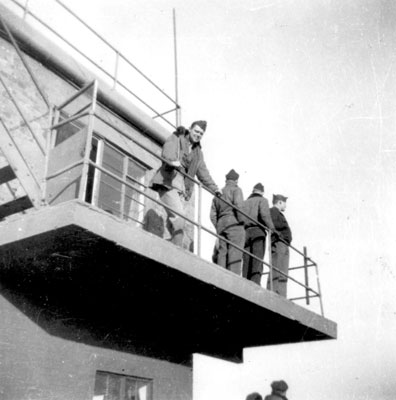THE EIGHTH AIR FORCE
 Hutmate Robert Ropa looks down nonchalantly from the balcony of the Debach Control Tower. From this porch a flare arched in the morning, the signal to begin the mission takeoffs. From this same viewpoint at the day's end, our planes were anxiously counted as they circled to land.
Hutmate Robert Ropa looks down nonchalantly from the balcony of the Debach Control Tower. From this porch a flare arched in the morning, the signal to begin the mission takeoffs. From this same viewpoint at the day's end, our planes were anxiously counted as they circled to land.
Debach
From Anglesey we followed a pilot plane to the assigned home field of the 493rd in England. We skimmed low over a verdant countryside whose parkland green contrasted with the dry Southwest and the barren High Plains of our training exercises. England was, indeed, "a green and pleasant land". But in southern England not only crops filled the fields. Many were stuffed with rows of war equipment: trucks, tanks, and guns for the coming invasion of "Festung Europa", "Fortress Europe" as the Nazis called their continental empire.
Our new base was Debach, Station 152, built in the fields outside the village. The runways, parking and storage areas, and our many Nissen huts and buildings were scattered over acres that had formerly produced grain. Not far from the base was the town of Woodbridge, about 5 miles to the southeast by road. Only 10 more miles south was the city of Ipswich. London was 60 miles farther.
The large bulge of England northeast of London, East Anglia, comprising Norfolk and Suffolk Counties, was an immense aircraft carrier. East Anglia contained not only scores of fields housing bombers and fighters of the daylight flyers of the Eighth Air Force but also the fields of the night-flying large planes of the Royal Air Force Bomber Command.
Within a few days of our settling in at our new base, "Axis Sally", a female radio announcer for the Nazis, broadcast a sneering welcome to the 493rd at Debach and promised us a warm reception over Fortress Europe. [Years later I read that British double agents supplied Axis Sally with innocuous tidbits such as our arrival in England. In this way the British lulled the Nazis into thinking they would get truly vital information from their spies. We have to thank many unknown people for keeping the time and objective of D-Day secret.]
New Procedures
In the three weeks after our arrival, we were introduced to Eighth Air Force procedures. My records show that our crew made 14 training flights in that short time. Our 493rd flyers had to learn how to form up 38 planes in crowded skies and to join a column of other bomber groups. Most of these duties fell to the pilots, but navigators were ordered to always keep careful track of the plane's position and to provide the pilot with the headings and timing needed in the assembly of an air armada.
Ours was one of the five original lead crews of the 861st squadron [and one of only two to survive a full tour]. We were to lead the squadron or to fly as deputy lead on the right wing of the leader, always ready to head up the formation. Our status was signified by a blue patch under our airman's wings. More important to us was that as a lead crew our combat tour was defined as thirty missions instead of the standard thirty-five. On the other hand, we knew that the German flak gunners and fighters took aim at planes heading formations.
Lead personnel were in constant training between combat missions. We were up in the air more than other crews. Every afternoon we checked the bulletin board to see what we were commanded to fly in the morning. Some days our exercises were cross-country flights over northern England. Other days, Mike aimed bombs at a raft mired in the mudflats near Felixstowe, east of Ipswich. My skills were called on when we flew as "weather ship", reporting conditions at the assembly altitude. Generally, I confirmed what the meteorologist had predicted. One winter morning, however, I was astonished to encounter winds blowing more than 100 miles an hour. Perhaps we touched the bottom of the jet stream, but in 1944 I'd never heard of it.
Liberating Europe with a B-24 "Liberator"
Back to Navigating Through World War II Home Page
 Hutmate Robert Ropa looks down nonchalantly from the balcony of the Debach Control Tower. From this porch a flare arched in the morning, the signal to begin the mission takeoffs. From this same viewpoint at the day's end, our planes were anxiously counted as they circled to land.
Hutmate Robert Ropa looks down nonchalantly from the balcony of the Debach Control Tower. From this porch a flare arched in the morning, the signal to begin the mission takeoffs. From this same viewpoint at the day's end, our planes were anxiously counted as they circled to land.